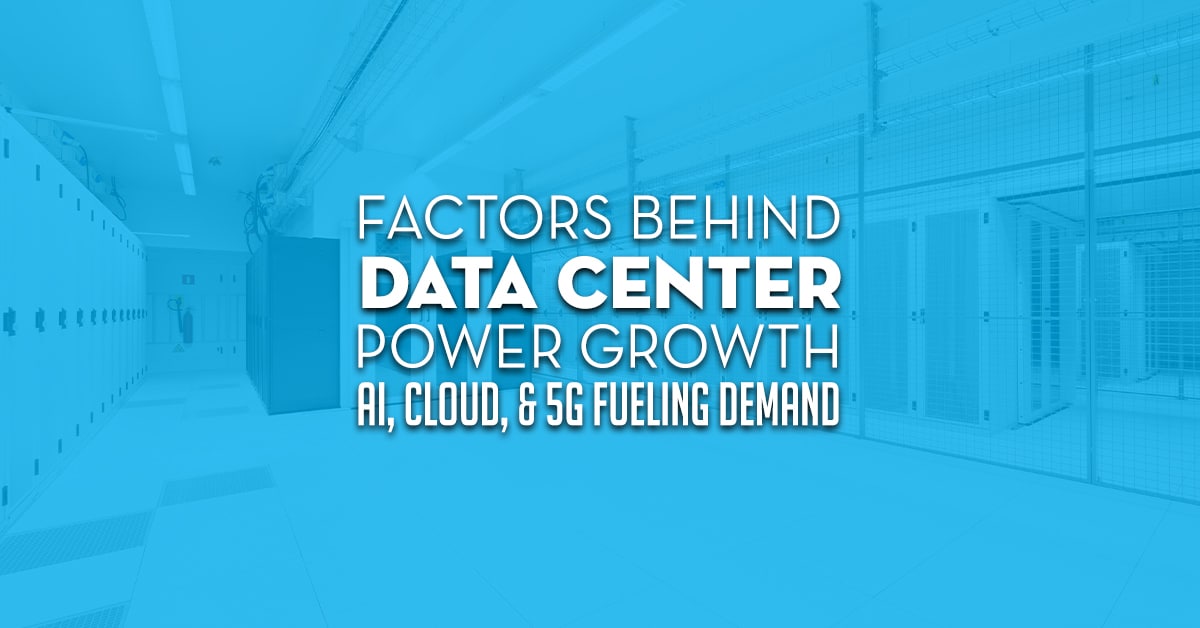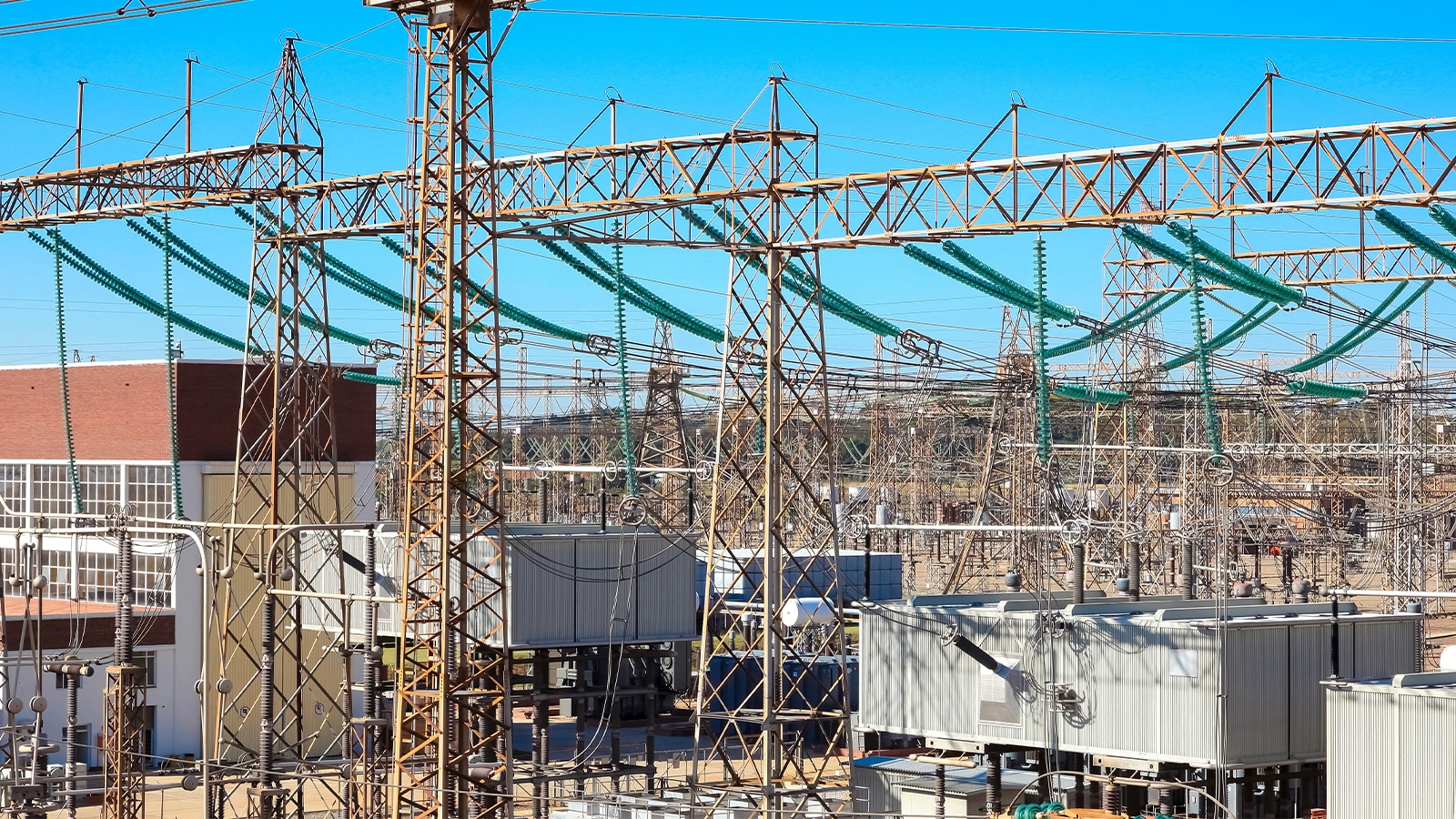An Introduction: Factors Driving Data Center Power and Energy Growth
As digital transformation accelerates, data centers have become the backbone of modern technology infrastructure. The demand for cloud services, artificial intelligence (AI), machine learning, and 5G connectivity has led to an unprecedented surge in power consumption.
The energy-intensive nature of data processing, combined with the need for reliability need for reliability and uptime, has put significant pressure on the power grid and sustainability initiatives. Below are the primary factors contributing to rising electricity demand in data centers.
Learn more about Navigating Data Center Power Demand and AI’s Impact on Electricity Needs.
Increased Cloud Computing Adoption
Growing demand for cloud services is driving the expansion of data centers, prompting higher power needs to maintain the new data centers and manage the associated increased workloads. Businesses across all industries are shifting their operations to cloud-based platforms to enhance scalability, security, and efficiency. This transition has resulted in large-scale data center construction by cloud service providers like Amazon Web Services (AWS), Microsoft Azure, and Google Cloud.
The cloud model relies on distributed computing, requiring which requires massive server farms with extensive networking and cooling systems. These facilities operate 24/7 to ensure continuous service availability, leading to a steady increase in power consumption. Additionally, multi-cloud and hybrid cloud strategies—where companies use a mix of public and private cloud solutions—further intensify the demand for stable infrastructure and available electricity.
As cloud computing continues to expand, energy-efficient innovations such as AI-driven workload management and renewable energy sourcing will play a crucial role in mitigating power usage.
AI and Machine Learning Workloads
Artificial intelligence and data processing significantly increase electricity consumption due to the required computational intensity. Demand Electricity demand growth is closely tied to increased AI applications, as those process significantly raiseing overall power consumption. AI workloads , (such as deep learning, neural networks, and real-time analytics), require vast amounts of processing power, often relying on high-performance GPUs (graphics processing units) and specialized AI chips.
The training of AI models, particularly large-scale generative AI and natural language processing (NLP) systems, consumes enormous amounts of energy.
A single AI training session for an advanced model can use as much electricity as several households over a year. As AI adoption expands in industries such as healthcare, finance, and autonomous systems, data centers must implement innovative cooling solutions, dynamic power scaling, and energy-efficient chip designs to address escalating power demands.
5G and Edge Computing Expansion
The rollout of 5G technology and subsequent edge computing expansion significantly drastically increases energy usage and power demand from data centers. These expansions demand new power solutions and associated infrastructure to maintain reliability.
5G networks are designed to deliver ultra-fast, low-latency connectivity, supporting applications such as autonomous vehicles, smart cities, and IoT-enabled industries. However, the deployment of 5G infrastructure requires a dense network of small cell towers, fiber-optic connections, and local edge data centers to process data closer to end users. This shift reduces latency but also increases the number of computing nodes, leading to higher overall electricity consumption.
Edge computing decentralizes data processing, distributing it across numerous smaller facilities instead of relying solely on massive centralized data centers. While this improves efficiency and speeds up data transfer, it also creates additional power challenges. Unlike traditional data centers that can optimize energy use at scale, edge facilities must maintain reliability in varied locations, often without direct access to renewable energy sources.
How Data Centers Consume Power
Services and IT Equipment
Servers, storage systems, networking equipment, and other IT hardware form the core of data center energy use. Rising computational demands, especially from AI workloads, drive data center load growth and higher power densities.
Cooling Systems
Cooling systems account for a significant portion of electricity usage. Increasing power density means cooling solutions must advance in energy efficiency to manage heat generation and keep energy consumption manageable.
Power Backup Systems
Backup power solutions, including batteries, diesel generators, and energy storage systems, ensure continuous operation during power disruptions. These systems significantly add to overall energy demand, particularly in maintaining readiness and emergency availability.
Power Generation and Its Role in Data Center Operations
Reliable power generation and supply and & demand management in the power system infrastructure are essential for supporting data center operations. New generation power sources and demand resources are essential for maintaining balance as electricity supply and demand fluctuates.
Importance of Reliable Power Supply
Continuous, reliable power supply is fundamental, ensuring uptime, reducing operational risks, and meeting data center operators’ high standards. Disruptions can significantly impact businesses relying on these services.
Types of Power Sources for Data Centers
As electricity demands from data centers continue to rise, industry leaders in the power sector are prioritizing innovative energy solutions to maintain efficiency, reliability, and sustainability. With the growing strain on electricity grids, data centers are integrating a mix of renewable energy sources, traditional power generation, and on-site energy solutions to ensure uninterrupted operations in the power needs of data centers.
Renewable Energy Sources
Data center owners increasingly adopt renewable energy, such as solar and wind power, aiming for clean energy solutions. However, these sources’ intermittent nature requires energy storage and supplementary solutions due to reliability concerns.
Renewable energy is a key component of data centers’ long-term sustainability strategies, with major operators investing in large-scale solar farms, wind turbines, and hydroelectric power agreements. Tech giants such as Google, Microsoft, and Amazon have committed to achieving carbon-neutral or net-zero emissions through substantial renewable energy investments. These initiatives reduce carbon footprints and help align data centers with global climate goals.
However, the unpredictable nature of solar and wind energy presents operational challenges. Since these sources are weather-dependent, they cannot consistently meet the high and continuous power demands of data centers without additional support.
To counter this, companies are integrating energy storage solutions such as large-scale battery systems, hydrogen fuel cells, and pumped hydro storage. These technologies store excess renewable energy during peak production times and release it when demand is high, enhancing reliability.
Another approach involves power purchase agreements (PPAs), where data centers partner with renewable energy providers to secure long-term, stable energy pricing while reducing their environmental impact.
By combining these efforts with advancements in AI-driven energy management, operators can optimize power distribution and minimize inefficiencies.
Traditional, Robust Power Generation
Traditional power plants connected to the standard power grid provide stable, predictable energy, crucial for supporting data centers’ higher power demands. While dependable, traditional sources face sustainability and environmental impact concerns.
Despite the push for renewable energy, data centers continue to rely on fossil fuel-based power plants, including coal, natural gas, and nuclear energy, to ensure consistent uptime. These conventional power sources offer high reliability and scalability, making them essential for mission-critical operations. However, their environmental impact, including greenhouse gas emissions and resource depletion, has raised concerns among regulators and industry leaders.
To address sustainability challenges, some power providers are transitioning to cleaner alternatives, such as natural gas plants with carbon capture technology and modern nuclear reactors with minimal waste output. Additionally, improvements in power grid efficiency, transmission infrastructure, and smart grid technology help optimize traditional power usage while minimizing waste and environmental impact.
On-Site Power Generation
On-site energy solutions, including combined heat and power (CHP) plants, new generation nuclear power plants, and energy storage solutions, provide reliable alternatives. These systems reduce dependency on external grids, enhancing operational continuity and energy security.
Many data centers are adopting on-site power generation to mitigate risks associated with grid instability, natural disasters, and energy price fluctuations. On-site energy solutions, including combined heat and power (CHP) plants, new generation nuclear power plants, and energy storage solutions, provide reliable alternatives. These systems reduce dependency on external grids, enhancing operational continuity and energy security.
CHP systems, also known as cogeneration plants, improve efficiency by simultaneously generating electricity and capturing waste heat for additional energy use. This dual-function capability makes CHP a cost-effective and sustainable alternative for large-scale facilities.
Another emerging solution is small modular reactors (SMRs), a next-generation nuclear technology designed for safe, efficient, and localized energy production. Unlike traditional nuclear plants, SMRs are more compact, produce less waste, and can be deployed closer to data centers for on-demand power generation. While still in early adoption phases, SMRs have the potential to provide long-term, carbon-free power for high-demand computing facilities.
Additionally, data centers are increasingly integrating advanced battery storage systems to complement on-site renewable energy generation. Lithium-ion and flow battery technologies enable facilities to store excess energy, reducing reliance on external power grids during peak hours. Fuel cells, such as hydrogen-based systems, are also gaining traction as a sustainable and scalable power source.
By diversifying energy strategies with a mix of renewable, traditional, and on-site generation solutions, data centers can achieve a balance between sustainability, reliability, and cost-effectiveness. As energy demands grow, innovation in power infrastructure will play a critical role in shaping the future of data center operations.
Summary – Demand For Data Center and Power Usage
Driven by the power needed for AI, cloud computing, and advanced technologies, managing power demand from data centers is increasingly critical. Energy efficiency, robust power infrastructure, energy storage, and clean energy adoption are central to sustainably addressing growing demand. Collaboration among data center developers, federal energy regulatory commissions, electric power research institutes, international energy agencies, and the department of energy will ensure available resources effectively support data center owners and operators, helping meet US power demand sustainably.

